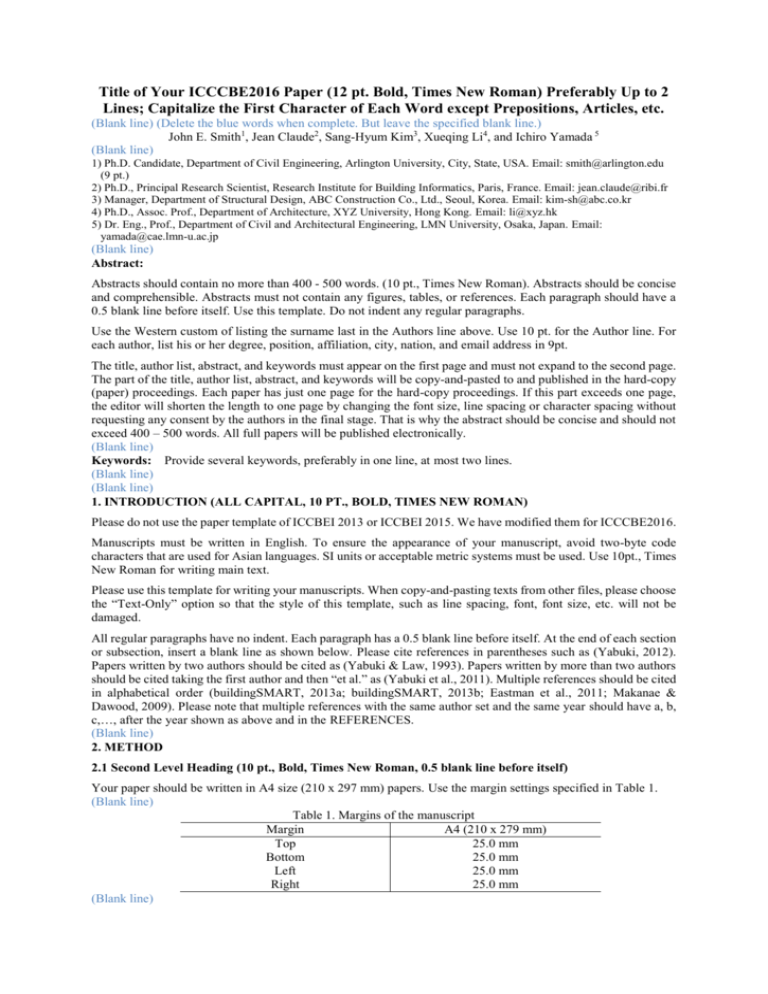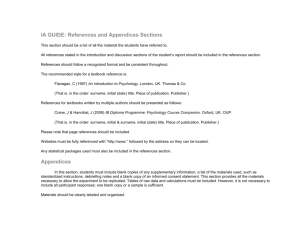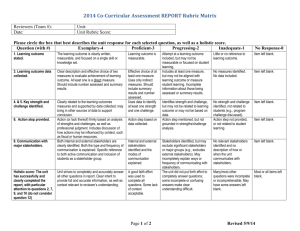here
advertisement

Title of Your ICCCBE2016 Paper (12 pt. Bold, Times New Roman) Preferably Up to 2 Lines; Capitalize the First Character of Each Word except Prepositions, Articles, etc. (Blank line) (Delete the blue words when complete. But leave the specified blank line.) John E. Smith1, Jean Claude2, Sang-Hyum Kim3, Xueqing Li4, and Ichiro Yamada 5 (Blank line) 1) Ph.D. Candidate, Department of Civil Engineering, Arlington University, City, State, USA. Email: smith@arlington.edu (9 pt.) 2) Ph.D., Principal Research Scientist, Research Institute for Building Informatics, Paris, France. Email: jean.claude@ribi.fr 3) Manager, Department of Structural Design, ABC Construction Co., Ltd., Seoul, Korea. Email: kim-sh@abc.co.kr 4) Ph.D., Assoc. Prof., Department of Architecture, XYZ University, Hong Kong. Email: li@xyz.hk 5) Dr. Eng., Prof., Department of Civil and Architectural Engineering, LMN University, Osaka, Japan. Email: yamada@cae.lmn-u.ac.jp (Blank line) Abstract: Abstracts should contain no more than 400 - 500 words. (10 pt., Times New Roman). Abstracts should be concise and comprehensible. Abstracts must not contain any figures, tables, or references. Each paragraph should have a 0.5 blank line before itself. Use this template. Do not indent any regular paragraphs. Use the Western custom of listing the surname last in the Authors line above. Use 10 pt. for the Author line. For each author, list his or her degree, position, affiliation, city, nation, and email address in 9pt. The title, author list, abstract, and keywords must appear on the first page and must not expand to the second page. The part of the title, author list, abstract, and keywords will be copy-and-pasted to and published in the hard-copy (paper) proceedings. Each paper has just one page for the hard-copy proceedings. If this part exceeds one page, the editor will shorten the length to one page by changing the font size, line spacing or character spacing without requesting any consent by the authors in the final stage. That is why the abstract should be concise and should not exceed 400 – 500 words. All full papers will be published electronically. (Blank line) Keywords: Provide several keywords, preferably in one line, at most two lines. (Blank line) (Blank line) 1. INTRODUCTION (ALL CAPITAL, 10 PT., BOLD, TIMES NEW ROMAN) Please do not use the paper template of ICCBEI 2013 or ICCBEI 2015. We have modified them for ICCCBE2016. Manuscripts must be written in English. To ensure the appearance of your manuscript, avoid two-byte code characters that are used for Asian languages. SI units or acceptable metric systems must be used. Use 10pt., Times New Roman for writing main text. Please use this template for writing your manuscripts. When copy-and-pasting texts from other files, please choose the “Text-Only” option so that the style of this template, such as line spacing, font, font size, etc. will not be damaged. All regular paragraphs have no indent. Each paragraph has a 0.5 blank line before itself. At the end of each section or subsection, insert a blank line as shown below. Please cite references in parentheses such as (Yabuki, 2012). Papers written by two authors should be cited as (Yabuki & Law, 1993). Papers written by more than two authors should be cited taking the first author and then “et al.” as (Yabuki et al., 2011). Multiple references should be cited in alphabetical order (buildingSMART, 2013a; buildingSMART, 2013b; Eastman et al., 2011; Makanae & Dawood, 2009). Please note that multiple references with the same author set and the same year should have a, b, c,…, after the year shown as above and in the REFERENCES. (Blank line) 2. METHOD 2.1 Second Level Heading (10 pt., Bold, Times New Roman, 0.5 blank line before itself) Your paper should be written in A4 size (210 x 297 mm) papers. Use the margin settings specified in Table 1. (Blank line) Table 1. Margins of the manuscript Margin A4 (210 x 279 mm) Top 25.0 mm Bottom 25.0 mm Left 25.0 mm Right 25.0 mm (Blank line) All tables must be consecutively numbered and inserted as close as possible to the corresponding text. In the text, refer its number to the table, as above, not its relative position. A table caption must appear centered and above each table. Do not insert page numbers. (1) Third Level Heading (10pt., Times New Roman) Equations are placed on separate lines, centered and numbered consecutively in parentheses at the right-hand margin. Equations must be referred in the main text. For example, “By Equation (1), we obtain Ti, the time consumed for the task Ai. Ti Mi 0 where a 2 b2 dt 3 axt 2 (1) Mi: Maximum level for i, a: work constant, b: level constant, x: work variable” This is just a sample of writing equations, constants and variables. (Blank line) 3. RESULTS Figures must be consecutively numbered and inserted as close as possible to the corresponding text. In the text, refer to the figure by its number, e.g., “as shown in Figure 1,” not its relative position. A figure caption must appear centered and below each figure. When pasting figures, especially, photographs, to your manuscript, please be aware of the size of the manuscript. Try to minimize the size of the graphic files, but not excessively so that they do not appear blurred. Characters in figures must be legible. Try to avoid non-English texts in figures. When writing abbreviations such as IFC, SHM, CFD, etc. first time in your manuscript, you should spell out each term first and then write its abbreviation in parentheses, e.g., Industry Foundation Classes (IFC), Structural Health Monitoring (SHM), Computational Fluid Dynamics (CFD), even if you think such abbreviated forms are commonsense in your field. Please be conscientious to readers in other fields. (Blank line) Introduction Body Conclusion (Blank line) Figure 1. General structure of reports, papers, and essays (Blank line) Leave a blank line above each first level heading. In addition, leave a blank line above each figure and below each figure caption, as shown around Figure 1. (Blank line) 4. DISCUSSION Avoid one-sentence paragraphs and paragraphs containing more than one main idea. While using the American English spelling style, e.g., “color,” “center,” “utilize,” is preferred in the proceedings, the UK style, e.g., “colour,”, “centre,” “utilise,” may be used so long as it is used consistently. (Blank line) 5. CONCLUSIONS All references in the reference list must be cited in the text and all references cited in the text must be in the reference list. References must be listed in alphabetical order. References of Internet webpages should include the authors’ latest accessed dates. The maximum page of a full paper is 8 pages. If your paper exceeds 8 pages, extra fee per page will be charged. Authors of excellent papers will be invited to submit modified and extended papers to special section or issue of notable journals. (Blank line) ACKNOWLEDGMENTS The author of this template would like to thank the author of the template for the manuscripts of the proceedings of the 30th International Symposium on Automation and Robotics in Construction and Mining (ISARC 2013). (Blank line) REFERENCES (Blank line) buildingSMART. (2013a). IFC2x3. Retrieved from buildingSMART website: http://www.buildingsmarttech.org/ifc/IFC2x3/TC1/html/index.htm, accessed on September 24, 2015. buildingSMART. (2013b). IFC4 Release Candidate 4. Retrieved from buildingSMART website: http://www.buildingsmart-tech.org/ifc/IFC2x4/rc4/html/index.htm, accessed on September 24, 2015. Eastman, C., Teicholz, P., Sacks, R., and Liston, K. (2011). BIM Handbook: A Guide to Building Information Modeling for Owners, Managers, Designers, Engineers, and Contractors (2nd ed.). John Wiley & Sons. Makanae, K. and Dawood, N. (2009). Development and evaluation of a tangible terrain representation system for highway route planning, Computer-Aided Civil and Infrastructure Engineering, 24 (3), 225-235. Yabuki, N. (2012). Impact of ICT to civil engineering and roles of civil engineers, Proceedings of the International Workshop on ICT in Geo-Engineering, Kyoto, Japan, pp.3-9. Yabuki, N. and Law, K.H. (1993). An object-logic model for the representation and processing of design standards, Engineering with Computers, 9 (9), 133-159. Yabuki, N., Miyashita, K., and Fukuda, T. (2011). An invisible height evaluation system to preserve good landscapes using augmented reality, Automation in Construction, 20 (3), 228-235.





